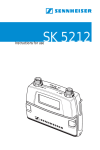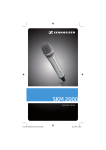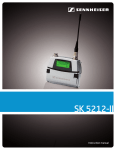Download Sennheiser SK 100 G3 - FREQUENCY SHEETS Specifications
Transcript
SK 100 Notice d’emploi Contents Contents Important safety instructions ........................................................................... 2 The SK 100 G3 bodypack transmitter.............................................................. 3 The frequency bank system ........................................................................ 3 Areas of application ...................................................................................... 4 Delivery includes................................................................................................... 5 Product overview.................................................................................................. 6 Overview of the SK 100 bodypack transmitter ....................................... 6 Overview of the displays.............................................................................. 7 Putting the bodypack transmitter into operation........................................ 8 Inserting the batteries/accupack ............................................................... 8 Charging the accupack.................................................................................. 8 Connecting the microphone cable/instrument cable ............................. 8 Attaching and positioning the microphones ........................................... 9 Attaching the bodypack transmitter to clothing................................. 10 Using the bodypack transmitter.................................................................... 11 Switching the bodypack transmitter on/off......................................... 11 Deactivating the lock mode temporarily ............................................... 12 Muting the audio signal or deactivating the RF signal ................................................................... 12 Selecting a standard display .................................................................... 13 Using the operating menu .............................................................................. 14 The buttons ................................................................................................. 14 Overview of the operating menu ............................................................ 14 Working with the operating menu ......................................................... 15 Adjusting settings via the operating menu ................................................ 17 The main menu “Menu” ............................................................................ 17 The extended menu “Advanced Menu” ................................................. 19 Adjustment tips................................................................................................. 22 Synchronizing the bodypack transmitter with a receiver.................. 22 Cleaning the bodypack transmitter .............................................................. 22 If a problem occurs ........................................................................................... 23 Specifications ..................................................................................................... 24 Connector assignment............................................................................... 25 Polar diagrams and frequency response curves of the microphones .................................................................................... 25 Manufacturer Declarations.............................................................................. 27 For more detailed information on the individual sections of this instruction manual, visit the SK 100 G3 product page on our website at www.sennheiser.com. There you can also view an animated instruction manual. 1 Important safety instructions Important safety instructions • Read this instruction manual. • Keep this instruction manual. Always include this instruction manual when passing the device on to third parties. • Heed all warnings and follow all instructions. • Clean the device only with a slightly damp cloth. • Do not place the device near any heat sources such as radiators, stoves, or other devices (including amplifiers) that produce heat. • Only use attachments/accessories specified by Sennheiser. • When replacement parts are required, only use replacement parts specified by Sennheiser or those having the same characteristics as the original part. Unauthorized substitutions may result in fire, electric shock, or other hazards. • Refer all servicing to qualified service personnel. Servicing is required if the device has been damaged in any way, liquid has been spilled, objects have fallen inside, the device has been exposed to rain or moisture, does not operate properly or has been dropped. • WARNING: To reduce the risk of short circuits, do not use the device near water and do not expose it to rain or moisture. Intended use Intended use of the ew 100 G3 series devices includes: • having read these instructions especially the chapter “Important safety instructions”, • using the devices within the operating conditions and limitations described in this instruction manual. “Improper use” means using the devices other than as described in these instructions, or under operating conditions which differ from those described herein. 2 The SK 100 G3 bodypack transmitter The SK 100 G3 bodypack transmitter The SK 100 G3 bodypack transmitter is part of the evolution wireless series generation 3 (ew G3). With this series, Sennheiser offers high-quality state-of-the-art RF transmission systems with a high level of operational reliability and ease of use. Transmitters and receivers permit wireless transmission with studio-quality sound. Features of the evolution wireless 100 G3 series: • Optimized PLL synthesizer and microprocessor technology • HDX noise reduction system • Pilot tone squelch control • True diversity technology • Switching bandwidth of 42 MHz • Increased immunity to intermodulation and interferences in multichannel operation The frequency bank system Please note: Frequency usage is different for each country. Your Sennheiser partner will have all the necessary details on the available legal frequencies for your area. The bodypack transmitter is available in 6 UHF frequency ranges with 1,680 transmission frequencies per frequency range: Range A: Range G: Range B: 516 – 558 MHz 566 – 608 MHz 626 – 668 MHz Range C: Range D: Range E: 734 – 776 MHz 780 – 822 MHz 823 – 865 MHz Each frequency range (A–E, G) offers 21 frequency banks with up to 12 channels each: Channel 1 – frequency preset Channel 2 – frequency preset Frequency bank 1 ... 20 Channel 12 – frequency preset Channel 1 – freely selectable frequency Channel 2 – freely selectable frequency Frequency bank U Channel 12 – freely selectable frequency Each of the channels in the frequency banks “1” to “20” has been factorypreset to a fixed transmission frequency (frequency preset). The factory-preset frequencies within one frequency bank are intermodulation-free. These frequencies cannot be changed. For an overview of the frequency presets, please refer to the supplied frequency information sheet. Updated versions of the frequency information sheet can be downloaded from the SK 100 G3 product page on our website at www.sennheiser.com. The frequency bank “U” allow you to freely select and store transmission frequencies. It might be that these transmission frequencies are not intermodulation-free. 3 The SK 100 G3 bodypack transmitter Areas of application The bodypack transmitter can be combined with the EM 100 G3 stationary receiver. The EM 100 G3 stationary receiver is available in the same UHF frequency ranges and is equipped with the same frequency bank system. This has the advantage that • a transmission system is ready for immediate use after switch-on, • several transmission systems can be operated simultaneously on the preset frequencies without causing intermodulation interference. Transmitter Receiver Combinable with SK 100 G3 EM 100 G3 • Clip-on microphones: ME 2, ME 4 • Headmics: ME 3 • Instrument cables: CI 1 40 25 10 RF PEAK 0 -10 -20 -30 AF 1. 1 ew100 G3 543.200 MHz P MUTE SET Overview of the microphones and instrument cables: Microphone/ instrument cable Type Pick-up pattern ME 2 clip-on microphone ME 4 clip-on microphone omni pre-polarized condenser microphone cardioid ME 3 headmic CI 1 instrument cable 4 cardioid – – Delivery includes Delivery includes The packaging contains the following items: 1 SK 100 G3 bodypack transmitter 2 AA size batteries, 1.5 V 1 instruction manual 1 frequency information sheet 5 Product overview Product overview Overview of the SK 100 bodypack transmitter 쐋 Microphone/instrument input (MIC/LINE), 3.5 mm jack socket, lockable MUTE switch Antenna Operation and battery status indicator, red LED (lit = ON/flashing = LOW BAT) Audio overmodulation indicator, yellow LED (lit = AF PEAK) Charging contacts SET button 왖/왔 rocker button (UP/DOWN) Battery compartment Battery compartment cover Battery compartment catches Infra-red interface ON/OFF button (serves as the ESC (cancel) key in the operating menu) Display panel, backlit in orange 6 Product overview Overview of the displays After switch-on, the bodypack transmitter displays the standard display “Frequency/Name”. For further illustrations and examples of the different standard displays, refer to page 13. The display backlighting is automatically reduced after approx. 20 seconds. 543.200 MHz ew100 G3 AF P MUTE Display Meaning Audio level “AF” Modulation of the bodypack transmitter with peak hold function When the transmitter’s audio input level is excessively high, the “AF” display shows full deflection and, in addition, the yellow AF PEAK LED lights up: Frequency Current transmission frequency Name User selectable name Transmission icon RF signal is being transmitted Lock mode icon Lock mode is activated “P” (Pilot) Pilot tone transmission is activated “MUTE” Microphone or line input is muted Battery status Charge status: approx. 100% approx. 70% approx. 30% charge status is critical, the red LOW BATT LED is flashing: 7 Putting the bodypack transmitter into operation Putting the bodypack transmitter into operation Inserting the batteries/accupack For powering the bodypack transmitter, you can either use two 1.5 V AA size batteries or the rechargeable Sennheiser BA 2015 accupack. 왘 Open the battery compartment by pushing the two catches in the direction of the arrows and open the cover . 왘 Insert the two batteries or the accupack as shown above. Please observe correct polarity when inserting the batteries/accupack. 왘 Close the battery compartment. The battery compartment cover locks into place with an audible click. Charging the accupack To charge the BA 2015 accupack: 왘 Insert the bodypack transmitter into the L 2015 charger (optional accessory). The L 2015 charger can only charge the combination BA 2015 accupack/bodypack transmitter. Standard batteries (primary cells) or individual rechargeable battery cells cannot be charged. Connecting the microphone cable/instrument cable The audio input is designed for the connection of both condenser microphones and instruments (e.g. guitars). DC powering of the condenser microphones is via the audio input (3.5 mm jack socket MIC/LINE ). 왘 Use one of the recommended Sennheiser microphones or the optional CI 1 instrument cable (see page 4). 왘 Connect the 3.5 mm jack plug from the Sennheiser microphone or instrument cable to the 3.5 mm jack socket MIC/LINE . 왘 Lock the 3.5 mm jack plug by screwing down the coupling ring of the cable. 왘 Via the operating menu, adjust the sensitivity of the microphone/line input (see page 17). 8 Putting the bodypack transmitter into operation Attaching and positioning the microphones ME 2 왘 Use the microphone clip to attach the microphone to clothing (e.g. tie, lapel). 왘 Attach the ME 2 microphone as close as possible to the sound source. The ME 2 clip-on microphone has an omni-directional pick-up pattern. It is therefore not necessary to position it precisely. ME 3 왘 Adjust the ME 3 headmic so that a comfortable and secure fit is ensured. The ME 3 headmic has a cardioid pick-up pattern. 왘 Position the microphone so that its sound inlet is directed towards the sound source (e.g. mouth). ME 4 왘 Use the microphone clip to attach the microphone to clothing (e.g. tie, lapel). The ME 4 clip-on microphone has a cardioid pick-up pattern. 왘 Position the ME 4 so that its sound inlet is directed towards the sound source (e.g. mouth). 9 Putting the bodypack transmitter into operation Attaching the bodypack transmitter to clothing You can use the belt clip to attach the bodypack transmitter to clothing (e.g. belt, waistband). The belt clip is detachable so that you can also attach the transmitter with the antenna pointing downwards. To do so, withdraw the belt clip from its fixing points and attach it the other way round. The belt clip is secured so that it cannot slide out of its fixing points accidentally. To detach the belt clip: 왘 Lift one side of the belt clip as shown. 왘 Press down the belt clip at one fixing point and pull it out of the transmitter housing. 왘 Repeat for the other side. 10 Using the bodypack transmitter Using the bodypack transmitter To establish a transmission link, proceed as follows: 1. Switch the receiver on (see the instruction manual of the receiver). 2. Switch the bodypack transmitter on (see below). The transmission link is established and the receiver’s RF level display “RF” reacts. Switching the bodypack transmitter on/off 왘 Push the two battery compartment catches and open the battery compartment cover . To switch the bodypack transmitter on (online operation): ON/OFF 왘 Briefly press the ON/OFF button . The bodypack transmitter transmits an RF signal. The standard display “Frequency/Name” appears on the display panel. The red ON LED lights up and the transmission icon is displayed. You can switch the bodypack transmitter on and deactivate the RF signal on switch-on. For more information, see below. To switch the bodypack transmitter off: ON/OFF 왘 Press the ON/OFF button until “OFF” appears on the display panel. The red ON LED goes off and the display panel turns off. When in the operating menu, pressing the ON/OFF button will cancel your entry (ESC function) and return you to the current standard display. To switch the bodypack transmitter on and to deactivate the RF signal on switch-on (offline operation): ON/OFF 왘 Press the ON/OFF button until “RF Mute On?” appears on the display panel. SET 왘 Press the SET button. The transmission frequency is displayed but the bodypack transmitter does not transmit an RF signal. The transmission icon is not displayed. 543.200 MHz ew100 G3 AF P MUTE Use this function to save battery power or to prepare a bodypack transmitter for use during live operation without causing interference to existing transmission links. 11 Using the bodypack transmitter To activate the RF signal: ON/OFF SET 왘 Briefly press the ON/OFF button. “RF Mute Off” appears on the display panel. 왘 Press the SET button. The transmission icon is displayed again. Deactivating the lock mode temporarily You can activate or deactivate the automatic lock mode via the “Auto Lock” menu item (see page 18). If the lock mode is activated, you have to temporarily deactivate it In order to be able to operate the bodypack transmitter: 왘 Press the rocker button. “Unlock?” appears on the display panel. SET 왘 Press the SET button. The lock mode is temporarily deactivated: When you are in the operating menu The lock mode is deactivated as long as you are in the operating menu. When one of the standard displays is shown The lock mode is automatically activated after 10 seconds. Prior to this, the lock mode icon flashes, indicating that the lock mode is being activated. 543.200 MHz ew100 G3 AF P MUTE Muting the audio signal or deactivating the RF signal The MUTE switch allows you to mute the audio signal or to deactivate the RF signal. Via the “Mute Mode” menu item, you can set the desired function of the MUTE switch (see page 20): Setting Slide the MUTE switch ... “AF On/Off” ... to the left (position MUTE) Mutes the audio signal ... to the right “RF On/Off” Unmutes the audio signal ... to the left (position MUTE) Deactivates the RF signal (offline operation) ... to the right “Disabled” Function Activates the RF signal (online operation) ... to the left (position MUTE) None 왘 From the “Mute Mode” menu item, select the desired setting (see page 20). 왘 Exit the operating menu. 왘 Slide the MUTE switch to the left, to the position MUTE. The bodypack transmitter reacts as indicated in the table. 12 Using the bodypack transmitter The current state of the muting function or the RF signal is displayed on the display panel of the bodypack transmitter: Audio signal is muted Transmitter’s display panel: “MUTE” is displayed Audio signal is activated (muting is canceled) Transmitter’s display panel: “MUTE” is not displayed RF signal is deactivated Transmitter’s display panel: Transmission icon is not displayed RF signal is activated Transmitter’s display panel: Transmission icon is displayed You can also deactivate the RF signal on switch-on. For more information, refer to the chapter “Switching the bodypack transmitter on/off” on page 11. Using the ON/OFF button, you can also activate/deactivate the RF signal during operation. To do so, briefly press the ON/OFF button and proceed as described on page 11. Selecting a standard display 왘 Press the rocker button to select a standard display: Contents of the display 543.200 MHz ew100 G3 AF “Channel/Frequency” P MUTE ew100 G3 B.Ch: 20.12 AF “Frequency/Name” P MUTE B.Ch: 20.12 543.200 MHz AF Selectable standard display “Channel/Name” P MUTE 13 Using the operating menu Using the operating menu The buttons Button Function of the button Press the ON/OFF button • Switches the bodypack transmitter on and off ON/OFF • Cancels the entry and returns to the current standard display (ESC function) • Deactivates the RF signal (special function, see page 12) Press the SET button SET • Changes from the current standard display to the operating menu • Calls up a menu item • Enters a submenu • Stores the settings and returns to the operating menu Press the rocker button • Selects a standard display • Changes to the next/previous menu item • Changes the setting of a menu item Overview of the operating menu Main menu “Menu” Sensitivity Frequency Preset Name Auto Lock Advanced Exit Display Extended menu “Advanced Menu” Tune Mute Mode Cable Emulation Pilot Tone LCD Contrast Reset Software Revision Exit Function of the menu item Main menu “Menu” Sensitivity Adjusts the sensitivity “AF” (see page 17) Frequency Preset Changes the frequency bank and the channel (see page 18) Name Enters the transmitter name (see page 18) Auto Lock Activates/deactivates the automatic lock mode (see page 18) Advanced Calls up the extended menu “Advanced Menu” (see page 19) Exit Exits the operating menu and returns to the current standard display Extended menu “Advanced Menu” Tune Sets the transmission frequencies for the frequency bank “U” (see page 19) Special function: Sets a channel and a transmission frequency for the frequency bank “U” (see page 19) Mute Mode Sets the mode for the MUTE switch (see page 20) Cable Emulation Emulates guitar cable capacities (see page 20) Pilot Tone Activates/deactivates the pilot tone transmission (see page 20) 14 Using the operating menu Display Function of the menu item LCD Contrast Adjusts the contrast of the display panel (see page 20) Reset Resets the bodypack transmitter (see page 21) Software Revision Displays the current software revision (see page 21) Exit Exits the extended menu “Advanced Menu” and returns to the main menu Working with the operating menu If the lock mode is activated, you have to deactivate it In order to be able to work with the operating menu (see page 11). By way of example of the “Sensitivity” menu, this section describes how to use the operating menu. Changing from the current standard display to the operating menu SET 왘 Press the SET button. The current standard display is replaced by the main menu. The last selected menu item is displayed. Selecting a menu item 왘 Press the rocker button to change to the “Sensitivity” menu item. The current setting of the selected menu item is displayed: Menu Sensitivity –12 dB Changing and storing settings SET Menu Sensitivity –12 dB Sensitivity – 12 dB Sensitivity –36 dB Call up “Sensitivity” Select the desired setting Store the setting SET “Stored” SET 왘 Press the SET button to call up the menu item. 왘 Press the rocker button to adjust the input sensitivity. SET 왘 Press the SET button to store the setting. The rocker button features a “fast search” function: Rocker button Display Press the UP button jumps to the previous menu item/setting Press the DOWN button jumps to the next menu item/setting Hold the button pressed cycles continuously Canceling an entry ON/OFF 왘 Press the ON/OFF button to cancel the entry. The current standard display appears on the display panel. To return to the last edited menu item: SET 왘 Press the SET button so many times until the last edited menu item appears. 15 Using the operating menu Exiting a menu item To return to the next higher menu level: 왘 Change to the “Exit” menu item. Menu Exit SET 왘 Confirm your selection. You return to the next higher menu level. To directly return to the current standard display: ON/OFF 16 왘 Press the ON/OFF button. Adjusting settings via the operating menu Adjusting settings via the operating menu Make use of the possibility to adjust settings via the operating menu of your receiver and to transfer these settings to the bodypack transmitter. For more information, refer to the instruction manual of the receiver. The relevant information is marked with the sync icon. For more detailed information on the operating menu, visit the SK 100 G3 product page at www.sennheiser.com. The main menu “Menu” Adjusting the input sensitivity – “Sensitivity” SET Menu Sensitivity –12 dB Sensitivity – 12 dB Sensitivity –36 dB Call up “Sensitivity” Select the desired setting Store the setting SET “Stored” Adjustment range: 0 to −60 dB, adjustable in steps of 3 dB The transmitter’s audio level display “AF” always indicates the audio level, even if the bodypack transmitter is muted, e.g. allowing you to check the adjusted sensitivity before live operation. B.Ch: 20.12 543.200 MHz AF P MUTE Input sensitivity adjusted ... Effect/display ... too high Close talking distances, speakers with loud voices or loud music passages cause overmodulation in the transmission link. The yellow AF PEAK LED lights up. The audio level display “AF” shows full deflection for the duration of the overmodulation. ... correctly The audio level display “AF” shows full deflection only during the loudest passages. ... too low The transmission link is undermodulated. This results in a signal with high background noise. The following figures are a guide to the best settings: Transmission situation Sensitivity setting Loud music/vocals −30 to −21 dB Presentations −21 to 0 dB Instrument input Electric guitars with single coil pickups −30 to −24 dB Electric guitars with humbucker pickups −45 to −30 dB Guitars with active electronics (active pickups, active EQs, piezo pickups) −45 to −30 dB 17 Adjusting settings via the operating menu Selecting the frequency bank and the channel manually – “Frequency Preset” SET SET Menu Frequency Preset B.Ch: 5.12 Frequency Preset B.Ch: 5.12 MHz Frequency Preset B.Ch: 1.12 MHz Call up “Frequency Preset” Select the frequency bank and confirm Select the channel; store the setting SET “Stored” When you are in the “Frequency Preset” menu item, the RF signal is deactivated. Overview of the frequency banks and channels: Frequency bank Channels Type “1” to “20” up to 12 per frequency bank System bank: frequencies are factor-preset “U” up to 12 User bank: frequencies are freely selectable When setting up multi-channel systems, please observe the following: Only the factory-preset frequencies within one frequency bank are intermodulation-free (see page 22). Bodypack transmitter and receiver of a transmission link have to be set to the same frequency. It is vital to observe the notes on frequency selection on page 22. Entering a name – “Name” SET SET Name Lichael Menu Name Name Michael Lichael Call up “Name” Enter a character and confirm Enter a character; store the setting SET “Stored” Via the “Name” menu, you can enter a freely selectable name (e.g. the name of the performer) for the bodypack transmitter. The name can be displayed on the standard displays “Frequency/Name” and “Channel/Name”. The name can consist of up to 8 characters such as: • letters (without pronounciation marks), • numbers from 0 to 9, • special characters and spaces. To enter a name, proceed as follows: 왘 Press the rocker button to select a character. SET 왘 Press the SET button to change to the next segment/ character or to store the complete entry. Activating/deactivating the automatic lock mode – “Auto Lock” SET Menu Auto Lock Active Call up “Auto Lock” Auto Lock Active Select the desired setting Auto Lock Inactive Store the setting SET “Stored” The lock mode prevents that the bodypack transmitter is accidentally switched off or programed during operation. The lock mode icon on the current standard display indicates that the lock mode is activated. 왘 Press the rocker button to select the desired setting. For information on how to use the lock mode, refer to page 12. 18 Adjusting settings via the operating menu The extended menu “Advanced Menu” Setting transmission frequencies and frequency banks – “Tune” When you have selected one of the system banks and then select the “Tune” menu, the bodypack transmitter automatically switches to channel 1 of the frequency bank “U”. In this case, “U.1” briefly appears on the display panel. Upon delivery, the channels of the frequency bank “U” are not assigned a transmission frequency. When you are in the “Tune” menu item, the RF signal is deactivated. Via the “Tune” menu item, you can set a transmission frequency to be stored in the current channel or you can select a different channel in the frequency bank “U” and assign it a transmission frequency. It is vital to observe the notes on frequency selection on page 22. Setting a transmission frequency for the current channel 왘 Press the rocker button until the “Tune” menu item appears. SET 왘 Press the SET button. The frequency selection appears. SET SET Tu n e 543 .200 MHz B.Ch: 20.1 Advanced Menu Tune 543.200 MHz Call up “Tune” Select the MHz value and confirm “Stored” Tu n e 544.200 MHz B.Ch: 20.1 Select the kHz value; store the setting SET 왘 Set the desired frequency. SET 왘 Press the SET button. Your settings are stored. You are back to the operating menu. Selecting a channel and assigning this channel a frequency 왘 Press the rocker button until the “Tune” menu item appears. SET 왘 Press the SET button until the frequency bank selection appears. Advanced Menu Tune 543.200 MHz SET Tu n e B.Ch: U. 1 Select the channel; store the setting Call up “Tune” (special function) “Stored” SET 왘 Set the desired channel. SET 왘 Press the SET button. The frequency selection appears. 왘 Set the desired frequency. 19 Adjusting settings via the operating menu Setting the mode for the MUTE switch – “Mute Mode” SET Advanced Menu Mute Mode AF On/Off Mute Mode RF On/Off Mute Mode AF On/Off Call up “Mute Mode” Select the desired setting Store the setting SET “Stored” Mode Function “AF On/Off” When the switch is in the MUTE position, no audio signal is transmitted. “RF On/Off” When the switch is in the MUTE position, the RF signal is deactivated. “Disabled” The muting function is deactivated. For information on how to use the MUTE switch, refer to page 12. Emulating guitar cables – “Cable Emulation” SET Advanced Menu Cable Emulation Medium Cable Emulation Call up “Cable Emulation” Select the desired setting Cable Emulation Medium High Store the setting SET “Stored” Via the “Cable Emulation” menu item, you can emulate different guitar cable capacities in order to influence the sound of your guitar. Activating/deactivating the pilot tone transmission – “Pilot Tone” Advanced Menu Name Pilot Tone Active Call up “Pilot Tone” SET Pilot Active Select the desired setting Pilot Inactive Store the setting SET “Stored” The bodypack transmitter adds an inaudible pilot tone to the audio signal. The receiver detects and evaluates the pilot tone, and is thus able to identify the signal of the matching transmitter and mute all others. The pilot tone supports the receiver’s squelch function. Devices of the ew 100 G1 series (generation 1) do not support the pilot tone function. Therefore, please observe the following when combining a bodypack transmitter or receiver of the ew 100 G3 series (generation 3) with devices from an earlier evolution wireless generation: Transmitter Receiver Make sure to ... w G3/ w G2 w G3/ w G2 ... activate the pilot tone function on both bodypack transmitter and receiver. w G3 w G1 ... deactivate the pilot tone function on the ew 100 G3 bodypack transmitter. w G1 w G3 ... deactivate the pilot tone function on the ew 100 G3 receiver. Adjusting the contrast of the display panel – “LCD Contrast” You can adjust the contrast of the display panel in 16 steps. 20 Adjusting settings via the operating menu Loading the factory-preset default settings – “Reset” Advanced Menu Reset Call up “Reset” SET Reset Yes Select the desired setting; apply the setting “Stored” SET When resetting the bodypack transmitter, only the selected settings for the pilot tone and for the frequency bank “U” remain unchanged. Displaying the software revision – “Software Revision” You can display the current software revision of the bodypack transmitter. 21 Adjustment tips Adjustment tips Synchronizing the bodypack transmitter with a receiver When synchronizing the bodypack transmitter with a receiver, please observe the following: 왘 Only use a bodypack transmitter and a receiver from the same frequency range (see the type plate on the transmitter and the receiver). 왘 Make sure that the desired frequencies are listed in the enclosed frequency information sheet. 왘 Make sure that the desired frequencies are approved and legal in your country and, if necessary, apply for an operating license. Synchronizing the bodypack transmitter with the receiver – individual operation Upon delivery, the bodypack transmitter and the receiver are synchronized with each other. However, if you cannot establish a transmission link between bodypack transmitter and receiver, you have to synchronize the channels of the devices. For information on automatic synchronization of the bodypack transmitter with the receiver (individual operation), refer to the instruction manual of the receiver. This information is marked with the icon. Alternatively, you can set the channel on the bodypack transmitter manually: 왘 Make sure that you set the bodypack transmitter to the same frequency bank and the same channel as the receiver (see page 18). If you still cannot establish a transmission link, refer to the chapter “If a problem occurs ...” on page 23. Synchronizing bodypack transmitters with receivers – multi-channel operation Combined with ew 100 G3 receivers, ew 100 G3 bodypack transmitters can form transmission links that can be used in multi-channel systems. In order to ensure an intermodulation-free transmission, use the same frequency bank for all transmission links. For information on automatic synchronization of bodypack transmitters with receivers (multi-channel operation), refer to the instruction manual of your receiver. Cleaning the bodypack transmitter CAUTION! Liquids can damage the electronics of the bodypack transmitter! Liquids entering the housing of the device can cause a short-circuit and damage the electronics. 왘 Keep all liquids away from the bodypack transmitter. 왘 Use a slightly damp cloth to clean the bodypack transmitter from time to time. Do not use any solvents or cleansing agents. 22 If a problem occurs ... If a problem occurs ... Problem Possible cause Possible solution Bodypack Lock mode is activated transmitter cannot be operated, “Locked” appears on the display panel Deactivate the lock mode (see page 12). No operation indication Batteries are flat or accupack is flat Replace the batteries or recharge the accupack (see page 8). No RF signal at the receiver Bodypack transmitter and receiver are not on the same channel Set the bodypack transmitter to the same channel as the receiver. Synchronize the bodypack transmitter with the receiver. Bodypack transmitter is out of range Check the squelch threshold setting on the receiver. Reduce the distance between bodypack transmitter and receiving antenna. RF signal available, no audio signal, “MUTE” appears on the display panel RF signal is deactivated (“RF Mute“) Activate the RF signal (see page 12). Bodypack transmitter is muted (MUTE) Cancel the muting (see page 12). Receiver’s squelch threshold is adjusted too high Reduce the squelch threshold setting on the receiver. Bodypack transmitter doesn’t transmit a pilot tone Activate or deactivate the pilot tone transmission (see page 20). Audio signal Bodypack transmitter’s Adjust the input has a high level sensitivity is adjusted too sensitivity of background low/too high (see page 17). noise / audio signal is distorted If a problem occurs that is not listed in the above table or if the problem cannot be solved with the proposed solutions, please contact your local Sennheiser partner for assistance. To find a Sennheiser partner in your country, search at www.sennheiser.com under “Service & Support”. 23 Specifications Specifications RF characteristics Modulation wideband FM Frequency ranges 516–558, 566–608, 626–668, 734–776, 780–822, 823–865 MHz (A to E, G, see page 3) Transmission frequencies 1,680 frequencies, tuneable in steps of 25 kHz 20 frequency banks, each with up to 12 factory-preset channels 1 frequency bank with up to 12 user programmable channels Switching bandwidth 42 MHz Nominal/peak deviation ±24 kHz/±48 kHz Frequency stability ≤±15 ppm RF output power at 50 Ω typ. 30 mW Pilot tone squelch can be switched off AF characteristics Compander system Sennheiser HDX AF frequency response microphone: 80–18,000 Hz line: 25–18,000 Hz Signal-to-noise ratio (1 mV, peak deviation) ≥ 110 dBA THD ≤0.9% Max. input voltage Microphone/Line 3 Vrms Input impedance Microphone/Line 40 kΩ, unbalanced/1 MΩ Input capacitance switchable Adjustment range of input sensitivity 60 dB, adjustable in 3-dB steps Overall device Temperature range –10°C to +55°C Power supply 2 AA size batteries, 1.5 V or BA 2015 accupack Nominal voltage 2.4 V Power consumption at nominal voltage typ. 180 mA (30 mW) with switched-off transmitter ≤25 μA Operating time typ. 8 hrs Dimensions 82 mm x 64 mm x 24 mm Weight (incl. batteries) approx. 160 g In compliance with Europe 24 EMC Radio Safety EN 301489-1/-9 EN 300422-1/-2 EN 60065, EN 62311 (SAR) Specifications Approved by Canada Industry Canada RSS 210 IC 2099A-G3SK limited to 806 MHz USA FCC-Part 74 FCC-ID: DMO G3SK limited to 698 MHz Microphones ME 3 ME 4 Microphone type condenser ME 2 condenser condenser Sensitivity 20 mV/Pa 1.6 mV/Pa 40 mV/Pa Pick-up pattern omni-directional cardioid cardioid Max. SPL 130 dB SPL 120 dB SPL 150 dB SPL Connector assignment 3.5 mm jack plug Mic Line Line Mic Polar diagrams and frequency response curves of the microphones Polar diagram ME 3 30° 60° 0° 0 Polar diagram ME 4 30° 30° 5 10 10 60° 60° 15 30° 60° 15 20 20 25 25 90° 0° 0 5 90° dB 120° 120° 90° 90° dB 120° 120° 2000 Hz 4000 Hz 125 Hz 500 Hz 8000 Hz 500 Hz 8000 Hz 1000 Hz 16000 Hz 1000 Hz 16000 Hz 125 Hz 250 Hz 150° 150° 180° 250 Hz 150° 150° 180° 2000 Hz 4000 Hz 25 Specifications Frequency response curve ME 2 dBV -10 -20 -30 -40 -50 -60 50 100 200 500 1.000 1k 2k 5k 10.000 10k 20k Hz 1.000 1k 2k 5k 10.000 10k 20k Hz 1.000 1k 2k Frequency response curve ME 3 dBV -40 -50 -60 -70 -90 -100 50 100 200 1m 500 5 cm Frequency response curve ME 4 dBV -10 -20 -30 -40 -50 -60 50 100 0° / 1 m 26 200 500 90° / 1 m 0° / 10 cm 5k 10.000 10k 20k Hz Manufacturer Declarations Manufacturer Declarations Warranty Sennheiser electronic GmbH & Co. KG gives a warranty of 24 months on this product. For the current warranty conditions, please visit our web site at www.sennheiser.com or contact your Sennheiser partner. In compliance with the following requirements • RoHS Directive (2002/95/EU) • WEEE Directive (2002/96/EU) Please dispose of the bodypack transmitter at the end of its operational lifetime by taking it to your local collection point or recycling center for such equipment. • Battery Directive (2006/66/EU) The supplied batteries or rechargeable batteries of the bodypack transmitter can be recycled. Please dispose of them as special waste or return them to your specialist dealer. In order to protect the environment, only dispose of exhausted batteries. CE Declaration of Conformity • 0682 • R&TTE Directive (1999/5/EU), EMC Directive (2004/108/EU), Low Voltage Directive (2006/95/EU) The declarations are available at www.sennheiser.com. Before putting the device into operation, please observe the respective country-specific regulations. Statements regarding FCC and Industry Canada This device complies with Part 15 of the FCC Rules and with RSS-210 of Industry Canada. Operation is subject to the following two conditions: (1) this device may not cause harmful interference, and (2) this device must accept any interference received, including interference that may cause undesired operation. This equipment has been tested and found to comply with the limits for a Class B digital device, pursuant to Part 15 of the FCC Rules. These limits are designed to provide reasonable protection against harmful interference in a residential installation. This equipment generates, uses and can radiate radio frequency energy and, if not installed and used in accordance with the instructions, may cause harmful interference to radio communications. However, there is no guarantee that interference will not occur in a particular installation. If this equipment does cause harmful interference to radio or television reception, which can be determined by turning the equipment off and on, the user is encouraged to try to correct the interference by one or more of the following measures: • Reorient or relocate the receiving antenna. • Increase the separation between the equipment and receiver. • Connect the equipment into an outlet on a circuit different from that to which the receiver is connected. • Consult the dealer or an experienced radio/TV technician for help. This class B digital device complies with the Canadian ICES-003. Changes or modifications made to this equipment not expressly approved by Sennheiser electronic Corp. may void the FCC authorization to operate this equipment. Before putting the device into operation, please observe the respective country-specific regulations! 27 Sennheiser electronic GmbH & Co. KG Am Labor 1, 30900 Wedemark, Germany www.sennheiser.com Printed in Germany Publ. 01/09 529669/A01


















































